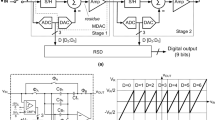Abstract
Recently announcement of a physical realization of a fundamental circuit element called memristor by researchers at Hewlett Packard (HP) has attracted so much interest worldwide. Combination of this newly found element with crossbar interconnect technology, opened a new field in designing configurable or programmable electronic systems which can have applications in signal processing and artificial intelligence. In this paper, based on the simple memristor crossbar structure, we will propose a new mixed analog-digital circuit as a hardware implementation of the sign–sign least mean square (LMS) adaptive filter algorithm. In this proposed hardware, any multiplication and addition is performed with infinite precision and there is no necessity for the quantization of the input signal. Since the coefficients of the filter are stored in the switches of the crossbar, they can remain unchanged theoretically for an infinite period of time.










Similar content being viewed by others
References
Strukov, D. B., Snider, G. S., Stewart, D. R., & Williams, R. S. (2008). The missing memristor found. Nature, 453, 80–83.
Yang, J. J., Pickett, M. D., Li, X., Ohlberg, D. A., Steward, D. R., & Williams, R. S. (2008). Memristive switching mechanism for metal/oxide/metal nanodevices. Nature Nanotechnology, 3, 429–433.
Chua, L. O. (1971). Memristor—the missing circuit element. IEEE Transactions on Circuit Theory, CT-18(5), 507–519.
Waser, R., & Aono, M. (2007). Nanoionics-based resitive switching memories. Nature Materials, 6, 833–840.
Kuekes, P. (2008). Material implication: Digital logic with memristors. In Memristor and memristive systems syymposium, 21 Nov 2008.
Pershin, Y. V., Fontaine, S. L., & Ventra, M. D. (24 Oct 2008). Memristive model of amoeba’s learning. arXive: 0810.4179v2.
Shin, S., Kim, K., & Kang, S. M. (2009). Memristor-based fine resolution resistance and its applications. In ICCCAS, July 2009.
Mouttet, B. L. (2009). Proposal for memristors in signal processing. In Nano-net 2008, pp. 11–13.
Mouttet, B. L. (2009). Crossbar comparator. US Patent 7,564,262.
Mouttet, B. L. (2009). Crossbar waveform driver circuit. US Patent 7,576,565.
Cioffi, J. M. (1987). Limited-precision effects in adaptive filtering. IEEE Transactions on circuits and systems, CAS-34(7), 821–833.
Haykin, S. (1991). Adaptive filter theory, 2nd edn. NJ: Prentice-Hall.
Treichler, J. R., Johnson, C. R., & Larimore, M. G. (1987). Theory and design of adaptive filters. New York: Wiley Interscience.
Gitlin, Jr, R. D., Meadors, H. C., & Weinstein, S. B. (1982). The tap-leakage algorithm: An algorithm for the stable operation of a digitally implemented, fractionally spaced adaptive equalizer. The Bell System Technical Journal, 61(8), 1817–1839.
Widrow, B. (October, 1960). An adaptive adaline neuron using chemical memristors. Stanford Electronics Laboratories Technical Report 1553-2.
Author information
Authors and Affiliations
Corresponding author
Rights and permissions
About this article
Cite this article
Merrikh-Bayat, F., Bagheri-Shouraki, S. Mixed analog-digital crossbar-based hardware implementation of sign–sign LMS adaptive filter. Analog Integr Circ Sig Process 66, 41–48 (2011). https://doi.org/10.1007/s10470-010-9523-3
Received:
Revised:
Accepted:
Published:
Issue Date:
DOI: https://doi.org/10.1007/s10470-010-9523-3




